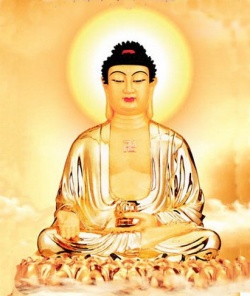Difference between revisions of "Amidabutsu Setsurin"
Jump to navigation
Jump to search
| (3 intermediate revisions by the same user not shown) | |||
| Line 3: | Line 3: | ||
| − | [[Amidabutsu Setsurin]] “A [[Japanese]] work (translated as | + | |
| + | |||
| + | |||
| + | |||
| + | |||
| + | |||
| + | |||
| + | |||
| + | |||
| + | |||
| + | |||
| + | <poem> | ||
| + | |||
| + | [[Amidabutsu Setsurin]] “A [[Japanese]] work (translated as [[Encyclopedia of Amitabha Buddha]]) composed by [[Zensho Keijo]] in the 13th century. | ||
It is composed of seven fascicles and is a collection of references to [[Amitabha Buddha]] and his [[Pure Land]] ([[Sukhavati]]) found in various [[Buddhist sutras]] and [[sastras]]. | It is composed of seven fascicles and is a collection of references to [[Amitabha Buddha]] and his [[Pure Land]] ([[Sukhavati]]) found in various [[Buddhist sutras]] and [[sastras]]. | ||
More than two hundred texts are mentioned by [[name]]. It is of great value for materials dealing with [[Pure Land Buddhism]].” ({{Wiki|Encyclopedia}} of [[Buddhism]], Vol. I: p.425) | More than two hundred texts are mentioned by [[name]]. It is of great value for materials dealing with [[Pure Land Buddhism]].” ({{Wiki|Encyclopedia}} of [[Buddhism]], Vol. I: p.425) | ||
| + | |||
| + | |||
| + | |||
{{E}} | {{E}} | ||
[[Category:Japanese Buddhism]] | [[Category:Japanese Buddhism]] | ||
[[Category:Amitabha]] | [[Category:Amitabha]] | ||
| + | {{JapaneseTerminology}} | ||
Latest revision as of 13:55, 2 April 2024
<poem>
Amidabutsu Setsurin “A Japanese work (translated as Encyclopedia of Amitabha Buddha) composed by Zensho Keijo in the 13th century.
It is composed of seven fascicles and is a collection of references to Amitabha Buddha and his Pure Land (Sukhavati) found in various Buddhist sutras and sastras.
More than two hundred texts are mentioned by name. It is of great value for materials dealing with Pure Land Buddhism.” (Encyclopedia of Buddhism, Vol. I: p.425)
